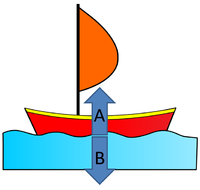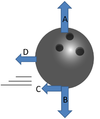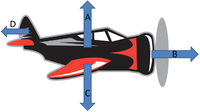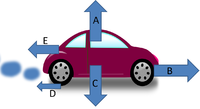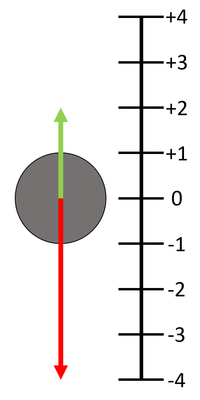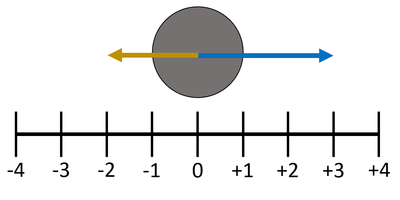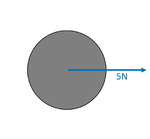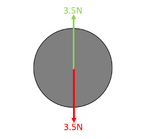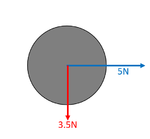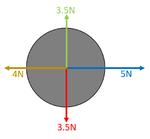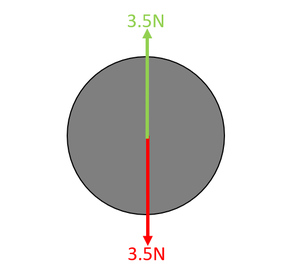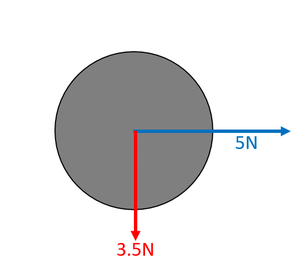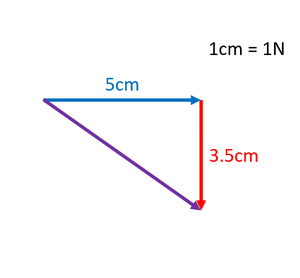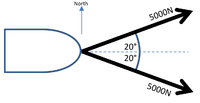Contents
Key Stage 2
Meaning
A force is something which can make an object; speed up, slow down or change shape.
- Noun: Force
About Forces
- A force can make an object speed up. When you let go of a pencil it will fall because a force called weight is making it speed up.
- A force can make an object slow down. When you roll a ball on the carpet it will slow down and stop because a force called friction has slowed it down.
- A force can change the shape of an object. When you tip a spoon of honey the honey will change shape and stretch because a force called weight pulls it into a long shape before dripping.
Key Stage 3
Meaning
A force is an influence that can change the speed, direction of motion or shape of an object.
About Forces
- The scientific units of force is the Newton (N). However, force can also be measured in pounds (lb) and ounces (Oz).
- Forces can be measured using a Newton Meter.
- Forces can be split into two groups, Contact Forces and Non-contact Forces.
| Contact Forces | Non-contact Forces |
- Forces can cause an object to accelerate.
- A pair of opposing forces can twist, stretch or squash an object. This is known as deformation.
Force Arrows
- Forces can be represented in a diagram with arrows that show the magnitude and direction of the force. A bigger arrow means a bigger force.
| A boat that is not moving. | A tennis ball falling. | A bowling ball moving to the right. |
|
| |
| A submarine travelling to the left. | A plane flying to the right. | A car driving to the right. |
|
|
|
Key Stage 4
Meaning
A force is a vector quantity that can affect the speed, direction of motion or shape of an object.
About Forces
- A force can be measured using a Newton Meter.
- The SI Unit of force is the Newton (N).
- A force is a vector quantity because it has both magnitude and direction.
- Forces follow Newton's Third Law which states that if an object 'A' exerts a force on object 'B'; then object 'B' will exert a force on object 'A' which is equal in magnitude but opposite in direction to the original force. These are sometimes called an action force and a reaction force. This means:
- When you push a wall with a force of 5N (Action Force), the wall pushes back with a force of 5N (Reaction Force).
- If 'head' a football with a force of 10N then your head provides a force of 10N (Action Force) to the ball and the ball provides a force of 10N to your head (Reaction Force).
- Forces can cause an object to accelerate.
- A pair of opposing forces applied to different parts of an object can twist, stretch or squash the object. This is known as deformation.
Forces as Vectors
Positive and Negative Direction
- When two forces act in opposite directions, along a line, one direction is chosen to be a positive direction and the other is chosen to be a negative direction, just as on a number line in maths.
| If the 'up' direction is chosen to be positive then any vector pointing 'up' has a positive value and any vector pointing 'down' has a negative value.
In this diagram the green vector has a value of +2 while the red vector has a value of -4. If the number lines represent the number of Newtons force then the Resultant Force is the two values added together. FResultant = (+2N) + (-4N) FResultant = -2N upwards |
| If the 'right' direction is chosen to be positive then any vector pointing 'right' has a positive value and any vector pointing 'left' has a negative value.
In this diagram the blue vector has a value of +3 while the yellow vector has a value of -2. If the number lines represent the number of Newtons force then the Resultant Force is the two values added together. FResultant = (+3N) + (-2N) FResultant = 1N to the right |
Forces on a Free Body Diagram
- To show force vectors a Free Body Diagram can be used, this indicates the magnitude and direction of the forces.
| This diagram shows an object with a vector force of 5N magnitude directed horizontally to the right. | This diagram shows an object with 2 forces of 5N magnitude in opposite directions, vertically. | This diagram shows an object with 2 forces. One of 5N magnitude directed horizontally to the right, the other 3.5N directed vertically down. | This diagram shows an object with 4 forces with pairs acting in opposing directions. The resultant force here is 1N horizontally to the right. |
Forces on a Scale Diagram
- Forces can be added using a scale diagram.
| The two vector forces drawn to a 'scale' on a Scale Diagram. This scale is 1N = 1cm. The two forces can be added by placing the start of one vector force at the end of the other. This Scale Diagram shows that the two forces cancel one another out so the net force is zero. | |
| The two vector forces drawn to a 'scale' on a Scale Diagram. This scale is 1N = 1cm. The two forces can be added by placing the start of one vector force at the end of the other. This Scale Diagram shows that the two arrows add to make a length of 6.1cm, which represents 6.1N, in a direction of 35° down from the horizontal. | |
| A boat is being pulled by two separate tug boats attached by a cable. The tension in each cable is 5000N. | The tug boats and cables are replaced by vector forces from the boat. | The two forces are redrawn in a a Scale Diagram with scale is 1000N = 1cm placing the start of one vector force at the end of the other. |
| This Scale Diagram shows that the two arrows add to make a length of 9.4cm, which represents 9400N, in a direction of 90° from the North which is an Easterly direction. | ||
Resolving Forces
| A boat is being pulled by two separate tug boats attached by a cable. The tension in each cable is 5000N. | The tug boats and cables are replaced by vector forces from the boat. | One of the forces is redrawn as the hypotenuse of a right angle triangle with height in the y-axis and base in the x-axis. |
| The total force North can be calculated by finding the height of each triangle.
\(F_y=5000\sin20\) \(F_y=1710N\) The force from the top tug boat is +1710N to the North and the force from the bottom tug boat is -1710N to the North]] so the total force North is zero. The total force East can be calculated by finding the base of each triangle. \(F_x=5000\cos20\) \(F_x=4698N\) The force from the top tug boat is +4698N to the East and the force from the bottom tug boat is +4698N to the East so the total force East is 9396N. | ||
References
AQA
- Forces, page 117, 118, GCSE Physics, Hodder, AQA
- Forces, pages 127, 128, GCSE Combined Science Trilogy; Physics, CGP, AQA
- Forces, pages 147, 148, GCSE Physics; The Complete 9-1 Course for AQA, CGP, AQA
- Forces, pages 208, GCSE Combined Science Trilogy 2, Hodder, AQA
Edexcel
- Forces, page 2, GCSE Physics, Pearson Edexcel
- Forces, page 286, GCSE Combined Science, Pearson Edexcel
- Forces, pages 181, 182, GCSE Combined Science; The Revision Guide, CGP, Edexcel
- Forces, pages 205, 206, GCSE Physics, CGP, Edexcel
- Forces; balanced, page 13, GCSE Physics, Pearson Edexcel
- Forces; balanced, page 297, GCSE Combined Science, Pearson Edexcel
- Forces; braking, pages 52, 53, GCSE Physics, CGP, Edexcel
- Forces; calculating, page 19, GCSE Physics, Pearson Edexcel
- Forces; calculating, page 303, GCSE Combined Science, Pearson Edexcel
- Forces; centripetal, pages 35, 185, 186, GCSE Physics, CGP, Edexcel
- Forces; change of momentum, page 46, GCSE Physics, CGP, Edexcel
- Forces; electrostatic, pages 255, 256, 264, GCSE Physics, CGP, Edexcel
- Forces; electrostatic, pages 82, 84, GCSE Physics; The Revision Guide, CGP, Edexcel
- Forces; equilibrium, page 152, GCSE Combined Science; The Revision Guide, CGP, Edexcel
- Forces; equilibrium, page 19, GCSE Physics; The Revision Guide, CGP, Edexcel
- Forces; equilibrium, pages 43, 209, GCSE Physics, CGP, Edexcel
- Forces; estimating, page 53, GCSE Physics, CGP, Edexcel
- Forces; extension, page 197, GCSE Physics, Pearson Edexcel
- Forces; extension, page 427, GCSE Combined Science, Pearson Edexcel
- Forces; falling bodies, page 17, GCSE Physics, Pearson Edexcel
- Forces; falling bodies, page 301, GCSE Combined Science, Pearson Edexcel
- Forces; free body force diagrams, pages 207-209, GCSE Physics, CGP, Edexcel
- Forces; gravitational, page 59, GCSE Physics; The Revision Guide, CGP, Edexcel
- Forces; gravitational, pages 37, 38, GCSE Physics, CGP, Edexcel
- Forces; interaction pairs, page 206, GCSE Physics, CGP, Edexcel
- Forces; magnetic, page 195, GCSE Combined Science; The Revision Guide, CGP, Edexcel
- Forces; magnetic, page 268, 269, 273-275, GCSE Physics, CGP, Edexcel
- Forces; magnetic, page 85, GCSE Physics; The Revision Guide, CGP, Edexcel
- Forces; moments, pages 211-213, GCSE Physics, CGP, Edexcel
- Forces; Newton’s First Law, pages 35, 36, 39-41, 46, GCSE Physics, CGP, Edexcel
- Forces; Newton’s Second Law, pages 35, 36, 39-41, 46, GCSE Physics, CGP, Edexcel
- Forces; Newton’s Third Law, pages 42, 43, 47, GCSE Physics, CGP, Edexcel
- Forces; pages 67-69, GCSE Physics; The Revision Guide, CGP, Edexcel
- Forces; pressure, pages 317-319, GCSE Physics, CGP, Edexcel
- Forces; resolving, page 182, GCSE Combined Science; The Revision Guide, CGP, Edexcel
- Forces; resolving, page 209, GCSE Physics, CGP, Edexcel
- Forces; resolving, page 68, GCSE Physics; The Revision Guide, CGP, Edexcel
- Forces; resultant, pages 12-13, 134, GCSE Physics, Pearson Edexcel
- Forces; resultant, pages 296-297, 376, GCSE Combined Science, Pearson Edexcel
- Forces; resultant, pages 33-35, 207, 208, GCSE Physics, CGP, Edexcel
- Forces; rotational, pages 136-137, GCSE Physics, Pearson Edexcel
- Forces; unbalanced, page 13, GCSE Physics, Pearson Edexcel
- Forces; unbalanced, page 297, GCSE Combined Science, Pearson Edexcel
- Forces; upthrust, pages 321, 322, GCSE Physics, CGP, Edexcel
- Forces; weight, pages 37, 38, GCSE Physics, CGP, Edexcel
- Forces; work done, pages 62, 63, 199, GCSE Physics, CGP, Edexcel
OCR
- Forces, page 163-166, 168, 170-173, Gateway GCSE Combined Science; The Revision Guide, CGP, OCR
- Forces, pages 26-33, 35-40, Gateway GCSE Physics; The Revision Guide, CGP, OCR
- Forces; Acceleration, pages 51-53, 56-57, 69, 83, 217, 222-223, 254-255, Gateway GCSE Physics, Oxford, OCR
- Forces; And electric current, pages 126-127, Gateway GCSE Physics, Oxford, OCR
- Forces; Braking, pages 196, Gateway GCSE Physics, Oxford, OCR
- Forces; Calculations, pages 69,196, 222, Gateway GCSE Physics, Oxford, OCR
- Forces; centripetal, page 97, Gateway GCSE Physics; The Revision Guide, CGP, OCR
- Forces; Collisions, pages 72-73, 199, 222-223, Gateway GCSE Physics, Oxford, OCR
- Forces; Constant forces, pages 194-195, Gateway GCSE Physics, Oxford, OCR
- Forces; Deceleration, pages 222, Gateway GCSE Physics, Oxford, OCR
- Forces; Effort, pages 86-87, Gateway GCSE Physics, Oxford, OCR
- Forces; Energy analysis, pages 194-199, Gateway GCSE Physics, Oxford, OCR
- Forces; Equilibrium, pages 67, Gateway GCSE Physics, Oxford, OCR
- Forces; Everyday forces, pages 70-71, Gateway GCSE Physics, Oxford, OCR
- Forces; Force-extension graphs, pages 81, Gateway GCSE Physics, Oxford, OCR
- Forces; Free body diagrams, pages 64-65, Gateway GCSE Physics, Oxford, OCR
- Forces; friction, pages 163, 205, Gateway GCSE Combined Science; The Revision Guide, CGP, OCR
- Forces; friction, pages 26, 29, 85, Gateway GCSE Physics; The Revision Guide, CGP, OCR
- Forces; Friction, pages 63, 66-67, Gateway GCSE Physics, Oxford, OCR
- Forces; Gears, pages 87, Gateway GCSE Physics, Oxford, OCR
- Forces; Gravitational potential energy, pages 83, 192, 197-199, Gateway GCSE Physics, Oxford, OCR
- Forces; Gravity constant, pages 82-83, 241, Gateway GCSE Physics, Oxford, OCR
- Forces; gravity, page 166, Gateway GCSE Combined Science; The Revision Guide, CGP, OCR
- Forces; gravity, pages 33, 86, 97, Gateway GCSE Physics; The Revision Guide, CGP, OCR
- Forces; Hydraulics, pages 88-89, Gateway GCSE Physics, Oxford, OCR
- Forces; In action, pages 78-79, Gateway GCSE Physics, Oxford, OCR
- Forces; Inertia, pages 66, Gateway GCSE Physics, Oxford, OCR
- Forces; Interactions, pages 62-63, Gateway GCSE Physics, Oxford, OCR
- Forces; Levers, pages 86, Gateway GCSE Physics, Oxford, OCR
- Forces; Load, pages 86-87, Gateway GCSE Physics, Oxford, OCR
- Forces; Machines, pages 86-87, Gateway GCSE Physics, Oxford, OCR
- Forces; Moment of, pages 84, Gateway GCSE Physics, Oxford, OCR
- Forces; Non-contact forces, pages 62, Gateway GCSE Physics, Oxford, OCR
- Forces; Potential energy, pages 83, Gateway GCSE Physics, Oxford, OCR
- Forces; Resolution of, pages 65, 71, Gateway GCSE Physics, Oxford, OCR
- Forces; Resultant forces, pages 65-68, Gateway GCSE Physics, Oxford, OCR
- Forces; resultant, pages 163, 164, Gateway GCSE Combined Science; The Revision Guide, CGP, OCR
- Forces; resultant, pages 26-28, Gateway GCSE Physics; The Revision Guide, CGP, OCR
- Forces; Rotation, pages 84, Gateway GCSE Physics, Oxford, OCR
- Forces; Springs, pages 78-80, 196-197, 252, Gateway GCSE Physics, Oxford, OCR
- Forces; Stretching of materials, pages 78-81, Gateway GCSE Physics, Oxford, OCR
- Forces; Turning forces, pages 84-85, Gateway GCSE Physics, Oxford, OCR
